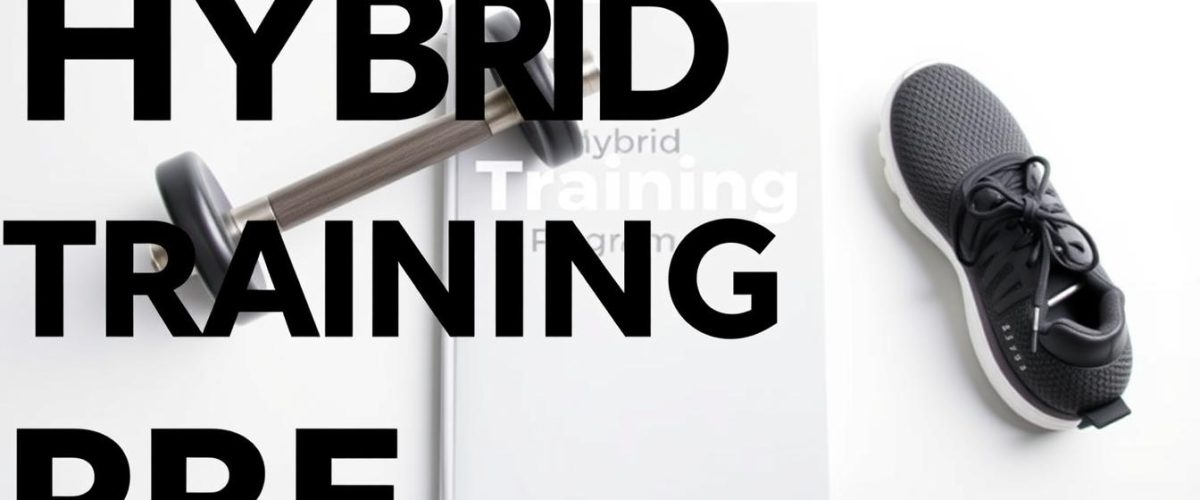You’re about to discover a fitness guide that blends strength and endurance exercises. A hybrid workout program boosts your fitness and performance.
Combining strength exercises with endurance activities raises your physical fitness level. It strengthens your body and improves heart health.
Start your fitness journey with a hybrid training PDF. A structured program helps you track progress and stay motivated to achieve your goals.
What is a Hybrid Training Program?
If you want to get stronger, last longer, and feel better, a hybrid training program could be just what you need.
This type of program mixes different workouts to improve your athletic skills. It combines various methods to help you get fit in a balanced way.
Definition and Overview
A hybrid training guide usually includes strength, endurance, and flexibility exercises. This mix helps you work on different parts of your fitness. It ensures you’re training in a well-rounded way.
What’s great about hybrid training is how flexible it is. It can be adjusted to fit anyone’s fitness level and goals, whether you’re just starting out or are already quite fit.
Benefits of Hybrid Training
The benefits of hybrid training are many. It lets you:
- Boost your fitness and athletic performance
- Work on strength, endurance, and flexibility
- Avoid getting stuck in a rut and prevent overtraining
- Become mentally tougher and more disciplined
Who Can Benefit from This Program?
Anyone wanting to get fitter can benefit from a hybrid training program. It’s perfect for athletes wanting to improve their game or anyone looking to get in shape.
It’s great for both beginners and advanced athletes. The hybrid training program is flexible, making it ideal for people with different fitness goals and levels.
Key Components of the Program
A good hybrid training program mixes strength, endurance, and flexibility. This mix helps you get fit without getting hurt or tired too easily.
Strength Training Focus
Strength training is key in any hybrid program. It boosts muscle strength and endurance. Compound exercises like squats, deadlifts, and bench presses are essential for building strength. They work many muscles at once, making them efficient for strength gains.
When planning your strength training, remember:
- Focus on compound exercises for better strength.
- Include exercises for both upper and lower body.
- Adjust the workout’s intensity and volume based on your level and goals.
Endurance Training Focus
Endurance training is also crucial. It boosts heart health and stamina. Running, cycling, and swimming are great for endurance. They improve heart health and help with daily activities and other physical tasks.
To get the most from endurance training:
- Choose activities you like and that challenge your heart.
- Slowly increase workout duration and intensity.
- Try interval training to boost stamina and performance.
Flexibility and Mobility Work
Flexibility and mobility exercises are vital for movement and injury prevention. Regular stretching and mobility drills improve flexibility, making strength and endurance training more effective. Yoga or Pilates can also boost flexibility and mobility.
To add flexibility and mobility to your routine:
- Stretch after workouts.
- Do mobility drills to improve joint movement.
- Add yoga or Pilates to your weekly plan.
As fitness expert
“A well-rounded fitness program must include a balance of strength, endurance, and flexibility training to achieve optimal results.”
Designing Your Hybrid Training Schedule
Creating a hybrid training schedule needs thought about your fitness goals and current level. It’s important to balance strength and endurance training. A good plan helps you get the most from your workouts.
Weekly Structure and Frequency
Figuring out your weekly training schedule is key. Think about how many days you can train each week. A 4- to 5-day split works well for most, mixing strength, endurance, and rest days.
Balancing Strength and Endurance
It’s vital to balance strength and endurance in your hybrid program. Make sure you spend enough time on both without overdoing it. Aim for 2-3 days of strength and 2-3 days of endurance, with a rest day in between.
Sample Weekly Schedule
Here’s a sample schedule to show how you can organize your training:
- Monday: Strength Training (Upper Body)
- Tuesday: Endurance Training (30 minutes of cardio)
- Wednesday: Strength Training (Lower Body)
- Thursday: Endurance Training (Interval Training)
- Friday: Strength Training (Core and Accessories)
- Saturday: Endurance Training (Long, steady-state cardio)
- Sunday: Rest or Active Recovery
This is just an example. You should tailor it to fit your goals, fitness level, and what you like.
Tips for Customizing Your Schedule:
- Begin with a schedule you can handle and increase as you get fitter.
- Pay attention to how you feel and adjust your workouts accordingly.
- Vary your strength exercises and endurance workouts to keep things interesting and prevent plateaus.
Recommended Equipment for Training
Having the right gear is key for good strength and endurance training. The right tools can make your workouts better, boost your performance, and help you reach your fitness goals faster.
Essential Strength Training Gear
For strength training, you need gear for various exercises. Some must-haves include:
- Dumbbells: Versatile and effective for many exercises.
- Resistance bands: Portable and great for adding resistance.
- Kettlebells: Excellent for dynamic movements and full-body exercises.
- Barbells: Ideal for compound exercises like squats, deadlifts, and bench presses.
Endurance Equipment Checklist
For endurance training, you need gear for better heart health. Key items are:
- Treadmill: Great for running and walking workouts.
- Stationary bike: Excellent for cycling and improving leg endurance.
- Elliptical trainer: Provides a low-impact, full-body workout.
- Rowing machine: Effective for full-body endurance training.
Optional Accessories to Enhance Workouts
While not necessary, some accessories can make your workouts better. These include:
- Jump rope: Excellent for improving cardiovascular fitness and coordination.
- Medicine balls: Great for core exercises and improving power.
- Exercise mat: Provides comfort and support during floor exercises.
- Foam roller: Helps with muscle recovery and flexibility.
Investing in the right equipment lets you create a well-rounded hybrid training program. It meets your strength and endurance needs.
Strength Training Techniques and Tips
To get the most out of strength training, knowing the right techniques is key. A good routine mixes strategies to reach your fitness goals.
Compound vs. Isolation Exercises
It’s important to know the difference between compound and isolation exercises. Compound exercises like squats and bench presses work many muscles at once. They help grow muscle and increase strength. Isolation exercises like bicep curls target specific muscles, helping to refine them.
Using both types of exercises in your routine is beneficial. Start with compound exercises to build a strong base. Then, use isolation exercises to focus on specific areas.
Form and Technique Guidelines
Keeping proper form and technique is crucial. It ensures you get the most from your workouts and avoids injuries. Here are some tips:
- Keep your posture right and engage your core.
- Choose a weight that lets you do the right number of reps with good form.
- Avoid jerky movements and focus on smooth actions.
- Breathe naturally, don’t hold your breath during lifts.
Good form makes exercises more effective and safer for your joints and muscles.
Progress Tracking for Strength Gains
Tracking your progress is key to getting stronger. Monitor your workout routine, including weights, reps, and how you feel.
Using a workout log or fitness app helps track your progress. Regularly checking your progress lets you adjust your routine to keep challenging yourself.
By focusing on strength training techniques and tracking your progress, you can make the most of your workouts.
Endurance Training Techniques and Tips
Improving your endurance is possible with specific training techniques. These include both aerobic and anaerobic exercises. Each type is important for better stamina and performance.
Aerobic vs. Anaerobic Training
Aerobic training involves low-to-moderate intensity exercises done for a longer time. Examples include jogging, cycling, or swimming. These activities boost your heart health and help your body use fat for energy.
On the other hand, anaerobic training includes high-intensity exercises done for a short time. These, like sprinting or weightlifting, use stored energy. Both aerobic and anaerobic training are key for a balanced program.

Building Stamina through Interval Training
Interval training is great for boosting stamina. It alternates between high-intensity exercise and rest. This method improves heart health and muscle endurance.
For example, try sprinting for 1 minute, then walk for 2 minutes. Repeat this for 20-30 minutes. Tailor the intensity and duration to your fitness level.
As you get better, increase the challenge by adjusting the intervals. This keeps your training effective.
Importance of Recovery in Endurance
Recovery is crucial in endurance training. It lets your body repair and adapt. Without enough rest, you might overtrain, leading to poor performance and injury risk.
Make sure to include rest days and get enough sleep. This balance is key for a successful training program.
Also, proper nutrition and hydration are essential for recovery. Eating a balanced diet and staying hydrated supports your body’s recovery. This improves your endurance.
Nutrition for Hybrid Training Success
To get the most out of hybrid training, you need to fuel your body right. Good nutrition gives you the energy you need and helps you recover. Eating well is key to doing your best and reaching your fitness goals.
Pre-Workout Nutrition Tips
Before you start your workout, eat something with carbs and protein. Complex carbohydrates like whole grains, fruits, and veggies give you energy. Adding lean protein like chicken, fish, or tofu helps your muscles work better.
Good pre-workout meals include oatmeal with banana and almond butter or a smoothie with Greek yogurt, berries, and spinach. Try to eat this meal 1-3 hours before your workout to digest it well.
Post-Workout Recovery Meals
After your workout, your body needs nutrients to heal and build muscle. Eating carbs and protein within 30-60 minutes helps. Simple carbohydrates like white bread or fruit quickly refill your energy. Protein helps fix and grow your muscles.
A good post-workout meal is chicken breast with quinoa and steamed veggies or a protein shake with banana. Proper nutrition after your workout is important for your progress.
Hydration Best Practices
Drinking enough water is key for both strength and endurance training. It helps keep your body cool, moves nutrients, and gets rid of waste. Aim to drink at least 8-10 glasses of water per day, more if you’re working out hard or in hot weather.
Check your hydration by looking at your urine color; it should be pale yellow. Also, use electrolyte drinks or supplements during long or hard workouts to replace lost salts.
Monitoring Your Progress
To get the most out of your hybrid training, it’s key to watch your progress closely. This lets you see how your body reacts to the training. You can then tweak your plan and stay motivated.
Tracking Strength Improvements
Keeping an eye on your strength gains is vital in hybrid training. Here’s how:
- Record your workouts and the weights you lift.
- Watch how many reps or sets you can do over time.
- Notice any increases in the weight you can lift.
Using a workout log or a mobile app can make tracking easier. It gives you valuable insights into your progress.
Measuring Endurance Gains
Measuring endurance gains means tracking your heart health during exercise. You can do this by:
- Monitoring your heart rate during and after exercise.
- Tracking the distance or time of your cardio sessions.
- Noting how quickly you recover.
Regularly checking your endurance shows how well your training is working. It also points out areas to improve.
Using Performance Metrics Effectively
Using performance metrics right is crucial for a great hybrid training program. Consider these metrics:
| Metric | Description | Example |
|---|---|---|
| Workout Time | Time taken to finish a workout | 45 minutes |
| Heart Rate | Heart rate during or after exercise | 120 bpm |
| Weight Lifted | Amount of weight lifted during strength training | 100 lbs |
By looking at these metrics, you can make smart choices about your training. Adjust your program as needed.
Modifying the Program for Specific Goals
The key to success with hybrid training is to tailor it to your goals. Whether you want to lose weight, gain muscle, or boost athletic performance, you can make changes to get better results.
Weight Loss vs. Muscle Gain
For weight loss, focus on your diet and workout intensity. Increasing your cardio sessions and eating fewer calories can help. To gain muscle, do progressive overload in strength training and eat enough protein.
Here are some tips for weight loss:
- Do more or harder cardio workouts.
- Keep an eye on your calorie intake to stay in deficit.
- Change your strength training to use lighter weights and more reps.
For muscle gain, try these:
- Do compound exercises like squats, deadlifts, and bench press.
- Eat more protein to help muscles grow.
- Keep lifting heavier weights over time.

Targeting Athletic Performance
To boost athletic performance, tailor your training to your sport. Use specific drills and exercises to improve endurance, agility, and strength. Interval training also helps.
Here’s how to target athletic performance:
- Use sport-specific training drills.
- Do interval training to boost stamina and speed.
- Work on strength training to increase power.
Adapting for Individual Fitness Levels
Hybrid training can be adjusted for any fitness level. Beginners start with lower intensity and volume and increase as they get fitter. Advanced folks can push their limits with harder workouts.
To adapt the program for your fitness level:
- Know your current fitness level and set achievable goals.
- Adjust the intensity and volume of your workouts.
- Keep increasing the challenge as you get more fit.
Safety Considerations in Hybrid Training
Safety in hybrid training is more than just avoiding injuries. It’s about making sure your workouts are both safe and effective. When you mix strength and endurance, it’s key to know your limits and take steps to stay safe.
Avoiding Common Injuries
Staying safe in hybrid training means avoiding common injuries. Here’s how:
- Use the right form and technique in your exercises.
- Don’t push too hard, especially in intense intervals.
- Do exercises that strengthen your core and boost flexibility.
Importance of Warm-Up and Cool-Down
A good warm-up and cool-down are vital for a safe workout. A warm-up gets your muscles ready, improving blood flow and lowering injury risk. A cool-down helps your body recover, easing muscle soreness and improving flexibility.
Listening to Your Body
Listening to your body is the most important safety tip. This means:
- Knowing when you’re tired and taking rest days when needed.
- Watching for pain or discomfort that could mean an injury.
- Changing your workout based on how your body feels.
By focusing on safety and listening to your body, you can get the most out of hybrid training while staying safe.
Community and Support for Hybrid Training
Starting your hybrid training journey can be better with friends. Being part of a community gives you motivation, support, and tips. These can really improve your training.
Finding Local Training Groups
Joining local training groups is a great way to get support. You meet people who want to reach the same fitness goals as you. Look for groups on:
- Social media platforms like Facebook and Meetup
- Local gyms and fitness studios
- Community centers and recreation departments
Training with others keeps you motivated and accountable. You also learn new things and get advice from others.
Online Resources and Forums
Online resources and forums are also key for support. Websites and apps for fitness offer:
- Workouts and training plans
- Nutrition advice and meal planning
- Community forums for discussion and support
Popular online spots include fitness blogs, YouTube channels, and fitness apps. They let you connect with more people, ask questions, and share your journey.
Connecting with Coaches and Trainers
Working with a coach or trainer offers personalized help. They can help you:
- Create a customized training plan
- Improve your form and technique
- Set and achieve your fitness goals
You can find coaches and trainers at local gyms, online, or through friends. Having a pro guide you can really help your hybrid training.
Download Your Hybrid Training Program PDF
Now that you know about the hybrid training program, it’s time to start. Downloading our PDF lets you follow a structured plan. It includes detailed workouts and nutrition advice.
Accessing the PDF
To get the downloadable hybrid training program pdf, just click the link. You can download it right away. This means you can start your fitness journey immediately.
Benefits of the PDF Format
The hybrid training PDF is easy to use and portable. You can also use it offline. It’s perfect for those who like a physical guide.
Effective Implementation
To make the most of your hybrid training program, follow these tips. Stick to your workout schedule, track your progress, and adjust your diet. Doing this will help you reach your fitness goals.


